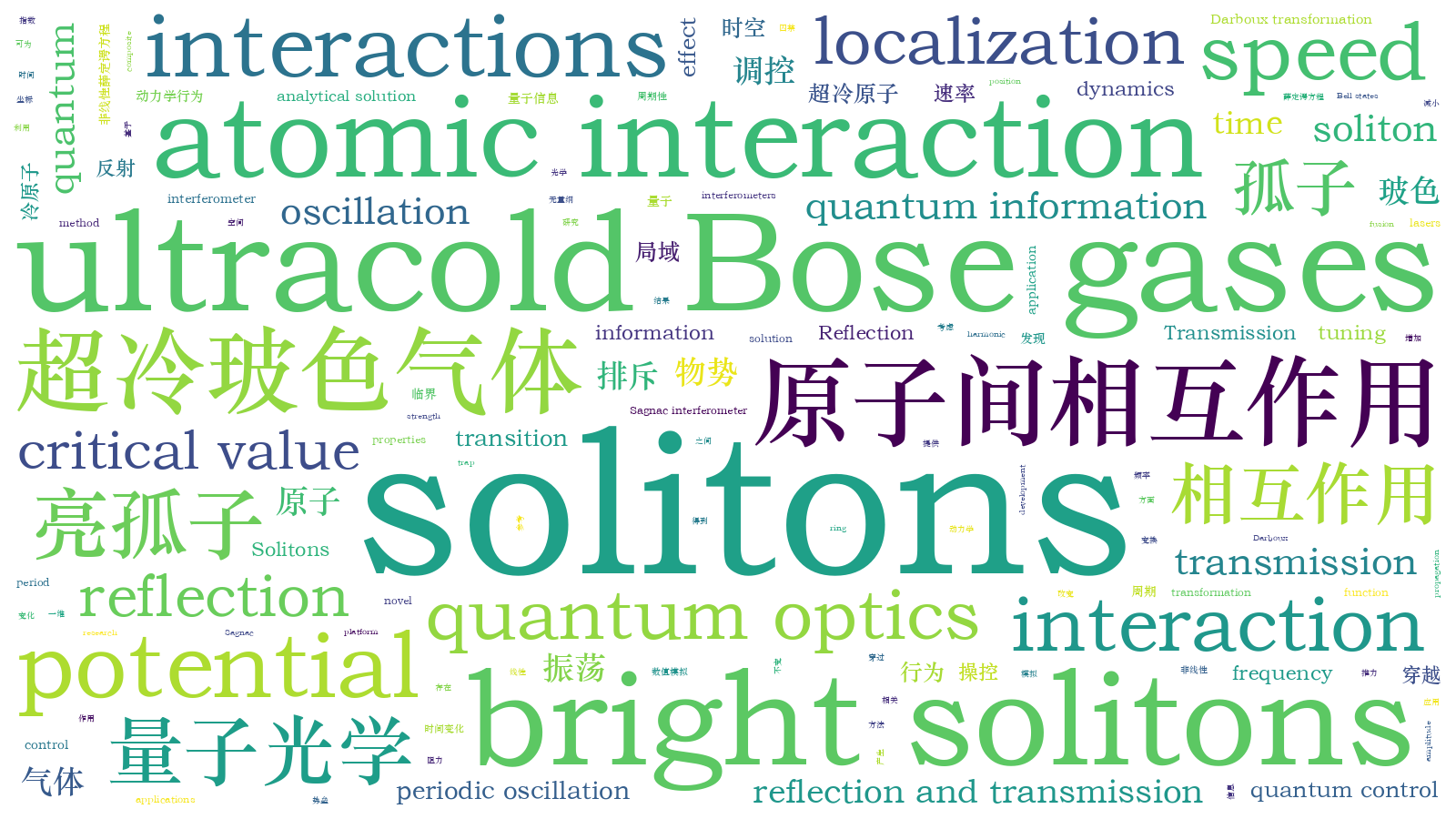排斥抛物势中相互作用时空调控的超冷玻色气体孤子的反射、局域、穿越与振荡行为操控
The experimental realizations of collisionally inhomogeneous ultracold Bose gases have not only greatly broadened the research scopes of ultracold atomic physics but also provided an ideal platform to explore novel quantum phenomena. Especially, studies on the peculiar properties and the novel quantum states and their quantum control in collisionally inhomogeneous ultracold Bose gases have been hot topics in the fields of both ultracold atomic physics and quantum information. The bright solitons of ultracold Bose gases have potential applications in quantum information, atomic interferometers, and atom lasers. Gertjerenken et al. predicted that the bright-bright solitons could be used to generate Bell states. Helm et al. found that the division and fusion of bright solitons in the ultracold Bose gases trapped in the ring well could be used to implement the Sagnac interferometer. Furthermore, in the composite potential composed of harmonic trap potential and Rosen-Morse barrier, the collision of the bright soliton can also be applied to the interferometer. In addition, stable propagation of bright solitons can be used to achieve atomic lasers. The precise control of the bright soliton in ultracold Bose gases is particularly important for the application of ultracold Bose gases.
Experiments have confirmed that the ultracold Bose gases can be controlled by adjusting the external potential and the interaction strength between atoms. With the development of experimental techniques, atomic interactions can be tuned by utilizing Feshbach resonance. In theoretical studies, several forms of time-dependent atomic interactions, such as the exponential function and the periodic function, have been proposed. The changed atomic interaction has an important effect on the properties of bright solitons in the ultracold Bose gases. For example, as atomic interaction increases, the amplitude of the bright soliton in the ultracold Bose gases increases, and its width decreases. When the atomic interaction exceeds a critical value, a transition behavior from oscillation to localization is observed in the ultracold Bose gases.
Firstly, we use the Darboux transformation to obtain the analytical solution of solitons in ultracold Bose gases with the time-dependent atomic interactions. Then, we explore the dynamics of solitons in the ultracold Bose gases with spatiotemporally modulated interactions in an expulsive parabolic potential by Crank-Nicolson method.
Firstly, we obtain the analytical solution of solitons in ultracold Bose gases by Darboux transformation. It is found that the atomic interaction increasing (decreasing) exponentially with time has a drag (push) effect on solitons in ultracold Bose gases with an expulsive parabolic potential (Fig. 2). Then, the dynamics behavior of bright solitons is explored by Crank-Nicolson method. There is a critical initial speed of solitons in the ultracold Bose gases with unchanged atomic interaction. When the initial speed of solitons is less than the critical value, a reflection behavior of solitons can be observed (Fig. 3). When the initial speed of solitons exceeds the critical value, a transmission behavior of solitons can be found (Fig. 4). When the initial speed of solitons is equal to the critical value, a localization behavior of solitons can be observed (Fig. 5). In order to investigate the effect of expulsive parabolic potential on this localization behavior of solitons, we calculate localization behaviors of solitons at different trapping frequencies. It is found that the critical initial speed of solitons increases with the trapping frequency (Fig. 6).
Subsequently, we consider the exponentially time-dependent atomic interactions. When the initial speed of solitons is equal to the critical value, a transition behavior from localization to reflection (transmission) is observed in the ultracold Bose gases with exponentially increasing (decreasing) atomic interactions (Fig. 7). When the initial speed of solitons is less than the critical value, the transition behavior from reflection to transmission is observed in the ultracold Bose gases with exponentially decreasing atomic interactions (Fig. 8). When the initial speed of solitons exceeds the critical value, the transition behavior from transmission to reflection can be found in the ultracold Bose gases with exponentially increasing atomic interactions (Fig. 9).
Finally, we calculate the dynamics behavior of bright solitons in the ultracold Bose gases with spatially modulated interactions in an expulsive parabolic potential. The localization behavior of solitons in the ultracold Bose gases with an expulsive parabolic potential can also be found (Fig. 10). Compared with that in Fig. 6, the critical local speed of the soliton in Fig. 11 decreases. Even if the initial speed is 0, the soliton can also pass through the potential barrier (Fig. 12). It is mainly attributed to the position-dependent atomic interaction. Meanwhile, a periodic oscillation of solitons with an expulsive potential barrier is newly observed (Fig. 12). The oscillation period of solitons can be controlled by tuning the atomic interaction (Fig. 13) and the trapping frequency of potential (Fig. 14).
In this paper, we analyze the reflection, localization, transmission, and oscillation behaviors of solitons in ultracold Bose gases with spatiotemporally modulated interactions in an expulsive parabolic potential, and find that: 1) the atomic interaction increasing (decreasing) exponentially with time has a drag (push) effect on solitons in ultracold Bose gases with an expulsive parabolic potential; 2) there is a critical initial speed of solitons in the ultracold Bose gases with unchanged atomic interaction, and a localization behavior of soliton can be observed at the critical speed; 3) the localization-reflection and transmission-reflection transitions of solitons are obtained by tuning the atom interactions; 4) a periodic oscillation of solitons with an expulsive potential barrier is newly observed, and the oscillation period of solitons can be controlled by tuning the atomic interaction and the trapping frequency of potential. These results can provide some help for the application of ultracold Bose gases in quantum information.
何章明, 朱钱泉, 潘湘. 排斥抛物势中相互作用时空调控的超冷玻色气体孤子的反射、局域、穿越与振荡行为操控[J]. 光学学报, 2023, 43(13): 1327001. Zhangming He, Qianquan Zhu, Xiang Pan. Reflection, Localization, Transmission, and Oscillation Behaviors of Solitons in Ultracold Bose Gases with Spatiotemporally Modulated Interactions in an Expulsive Parabolic Potential[J]. Acta Optica Sinica, 2023, 43(13): 1327001.







